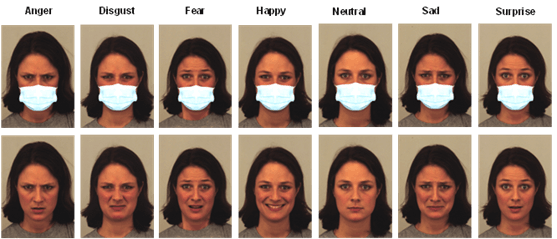Since the onset of the worldwide pandemic, face masks have been widely adopted to control the spread of COVID-19. While masks are critical for mitigating disease contagion, they hide parts of our faces which are used for nonverbal communication to express our emotions and intentions.
A team of researchers from the Laboratory for Attention and Social Cognition at McGill University compared how over 120 individuals recognize emotions: happy, sad, fearful, angry, disgusted, surprised, and neutral facial expressions in masked and unmasked faces. Not surprisingly, they found that face masks reduced the ability to recognize facial expressions for all emotions. Thus, obscuring face parts alters human social communication.
Q&A with Jelena Ristic, Full Professor and William Dawson Scholar and Sarah McCrackin, Postdoctoral Fellow, Department of Psychology
What question(s) did you set out to answer?
Humans have evolved to communicate via the silent language of faces. As a result, we are able to read a number of simple (e.g., eye gaze) and complex (e.g., intentions) social messages from faces alone. One of the most important cues we receive from faces is facial expression, which signals the individual’s emotional state.
With the sudden and widespread adoption of face masks in 2020 to curb the COVID-19 pandemic, we set out to investigate how covering the lower part of the face with a mask impacted our ability to recognize basic emotions from facial expressions. We also wanted to assess if this behavior varied with individual participants’ personality traits and their level of social ability.
What did you find?
Our data showed that recognition of all facial expressions was affected when faces were masked, reducing overall recognition accuracy by about 24%. However, this reduction varied with emotion; identification of disgust (46% accuracy reduction) and anger (30%) were impacted the most by masks. Sadness (23%) and neutral expressions (23%) were impacted an intermediate amount. Fear (10%), surprise (15%), and happiness (15%) were impacted the least.
The magnitude of the impact of masks on emotion recognition demonstrates that visual information from lower face is important for reading emotions from facial expressions. For example, because recognition of disgust and anger were most impacted by obscuring the lower face, we concluded that these two expressions most strongly utilize social cues from this facial area.
Correlation analyses indicated that the effects were generally stable across individuals, with little variation with individual traits. People who ranked higher in terms of trait agreeableness, which includes attributes like altruism and prosocial behavior, had slightly better emotion recognition when faces wore masks compared to people lower in trait agreeableness. In contrast, those higher in extroversion, characterized by a tendency to seek out social contact, had slightly worse emotion recognition when faces wore masks than those lower in extroversion. Finally, those who showed higher levels of social competence were better able to recognize emotional expression from unmasked faces than those with lower social competence.
Why are the results important?
The human social landscape underwent rapid change with the worldwide onset of the COVID-19 pandemic in early 2020. One of the biggest changes was an unprecedented and widespread adoption of face masks. While we want to emphasize that wearing a mask is critical in preventing the spread of COVID-19, it is also important that we understand the impact that face masks may have on human social interactions. This is especially true in a time where many are feeling socially isolated, given that the ability to recognize facial expressions is a fundamental part of social interactions and is linked to overall social and cognitive functioning.
Beyond the pandemic, these results have importance for health and educational settings in which masks have been or have become commonplace. For example, doctor-patient relations require easy interpretation of emotional states for better patient outcomes. Anger and sadness are two emotions that commonly come up when dealing with difficult medical problems, and our data suggest these emotions are two of the most impacted by masks. Further, as human psychosocial development depends on accurate interpretation of social cues from faces, mask wearing in educational settings may exert long lasting consequences for social development in children. While the need to wear masks in the pandemic is unquestionable, one recommendation that follows from our preliminary data from the ongoing studies on this topic is that wearing FDA approved transparent face masks may help to alleviate some (but not all) of the social difficulties resulting from facial occlusion by masks.
In summary, our study shows that human social functioning has been heavily impacted by the pandemic in more ways than perhaps we considered.
About this study
“Face masks impair basic emotion recognition: Group effects and individual variability” by Sarah McCrackin, Francesca Capozzi, Florence Mayrand, and Jelena Ristic published in Social Psychology.


